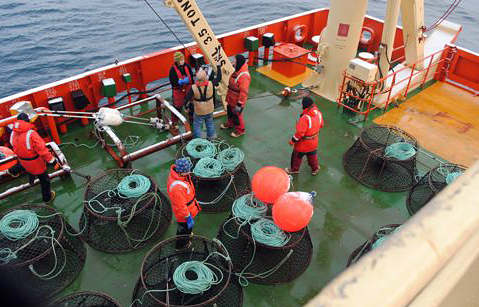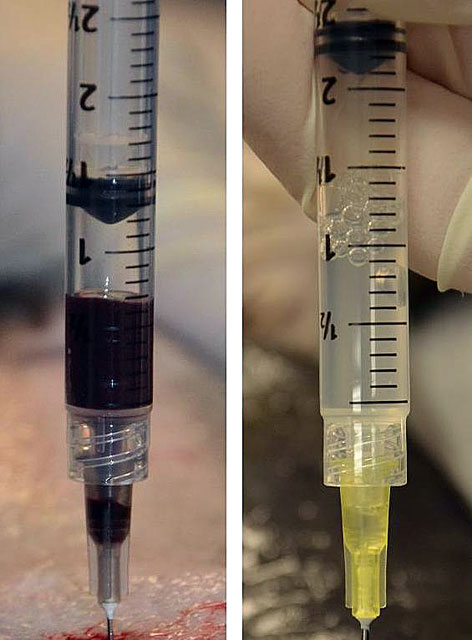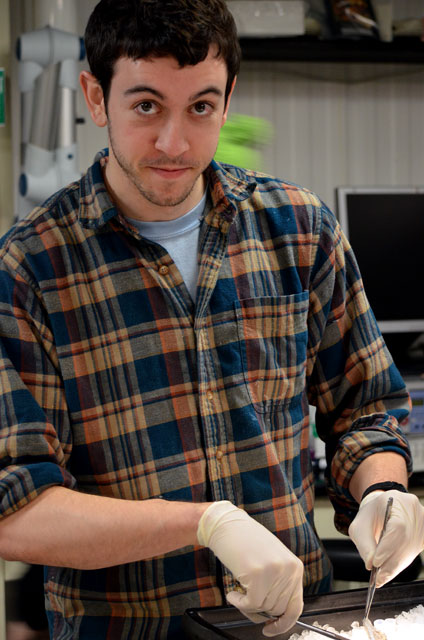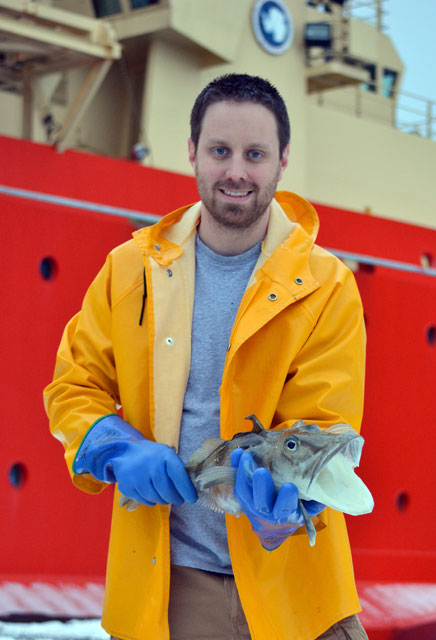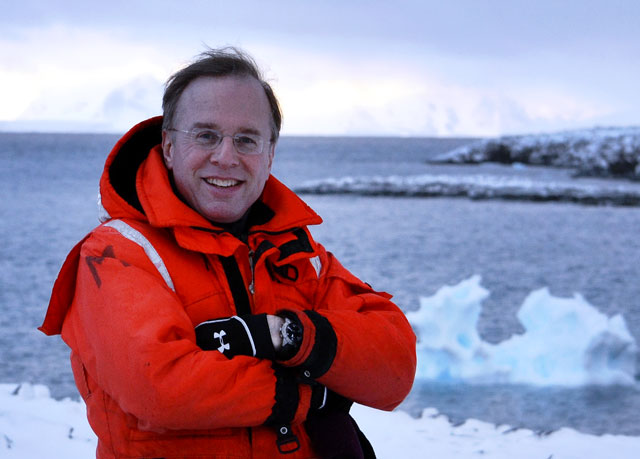Page 3/3 - Posted July 1, 2011
Will Antarctic ecosystem adapt or unravel from climate pressures?Just off the rear deck, inside Bio Lab, first-year grad student Devin Devor was checking the temperature of the seawater in the experimental tank. Zero-point-five degrees centigrade, just right for the baseline studies of the icefish (in this case a species called Chaenocephalus aceratus) and the N. coriiceps, the red-blooded animals. One by one, as each fish equilibrates in the tank, Devin removes it into a bucket of anesthetic and takes it next door to Lab 1, where Kristen swiftly withdraws a sample of arterial blood from the dorsal aorta and Lisa draws a sample of mixed venous blood from the two-chambered heart. Devin then takes the fish down the hall to Lab 10, where he and senior Fairbanks, Alaska, grad student Irina Müeller collect tissues surgically for analysis back home, using some of the same instruments that have served me for decades in the operating room. Meanwhile, across the building in Lab 1, Kristin determines the oxygen tension in the arterial blood and Lisa uses an analyzer and reagent cartridges from the station’s clinic to record some of the same blood parameters that I measure routinely in critically ill patients, including pH, oxygen and carbon dioxide gas pressures, bicarbonate level, base excess and accumulated lactic acid. They repeat the same process over and over again, methodically increasing seawater temperatures, first with N. coriiceps and then icefish, with and without supplemental oxygen in the water. From the clockwork to the chemistry, their operation feels like an acute-care surgery center. I am very much at home. I can relate to their long hours and to the physiology of their fish. As the seawater heats up ands carries progressively less oxygen, the N. coriiceps do fine until 17 degrees Celsius, when they lose their balance, wobble sideways and occasionally swim upside-down. They become, as I do on occasion, seasick. As expected, much the same happens with icefish, albeit at a lower temperature of 13 degrees Celsius. But the notothenioids fight back. The blood tests confirm that they hyperventilate, just like the occasional newbie, fresh off the plane at South Pole, laboring to breathe in the meager high-altitude atmosphere. And just like a patient who struggles against dyspnea (shortness of breath), giving the hypoxic notothenioids supplemental oxygen, by bubbling it into the water they breathe, causes them to stop gasping. The blood chemistry also reveals striking metabolic derangement in the hyperthermic fish of both species. By the time the fish start wobbling in the water, the syndrome is full-blown and severe. To me, after 30 years of medical experience with Homo sapiens, these findings are not at all fishy. They denote clinical shock, a condition resulting from the heart’s inability to deliver adequate oxygen to the body’s organs, or the inability of those organs to utilize the oxygen that comes their way, or both. At the higher temperatures, hemoglobin loses some of its affinity for oxygen, and blood plasma, like seawater, can dissolve less of it. Not surprisingly, supplemental oxygen mitigates the signs of shock in both species, so at least some of the effects of heat likely stem from problems with oxygen delivery in the fishes. Once Kristin, Lisa and their teams complete their analysis of the experimental tissues and the reams of data they collected during their time at Palmer Station this year, perhaps we will learn to what extent warmth diminishes the notothenioids’ ability to carry oxygen to its tissues and to what extent it interferes with its tissues’ ability to utilize oxygen. What is certain is that the waters around Antarctica’s peninsula have warmed by 1 degree centigrade during my lifetime alone. If continued unchecked, that rate portends doom for these enchanting creatures long before the end of this millennium. Jeffrey Grim Jeff studies molecular signaling in the genes of notothenioid embryos as they develop in the egg under conditions potentially mimicking a warming ocean, where oxygen is scarcer but reactive oxygen species may be more abundant. In such an environment different genes might be activated, or the same genes might be regulated differently, and produce a different kind of fish, one with a more buoyant, cartilaginous skeleton in the case of the N. coriiceps, for example. Maybe, just maybe, Antarctica’s fishes will reinvent themselves as their world — and ours — changes. For my part, it’s hard not to take all of this just a little bit personally. Having kept company with the glacier on its own terms and exchanged smiles of delight with the icefish, I suffer pangs of sadness that after millions of years both are now fleeting. But that’s Antarctica — a place where under the next rock or in the next plant frond or sea star might be hiding the next wonder drug. Where every day begins with excitement and ends with new understandings about oneself and the world, learned only by trekking to the ends of the Earth. Dr. Steven Untracht is a surgeon who also holds a Ph.D. in biophysics and theoretical biology from the University of Chicago Further Reading
|



For USAP Participants |
For The Public |
For Researchers and EducatorsContact UsU.S. National Science FoundationOffice of Polar Programs Geosciences Directorate 2415 Eisenhower Avenue, Suite W7100 Alexandria, VA 22314 Sign up for the NSF Office of Polar Programs newsletter and events. Feedback Form |

